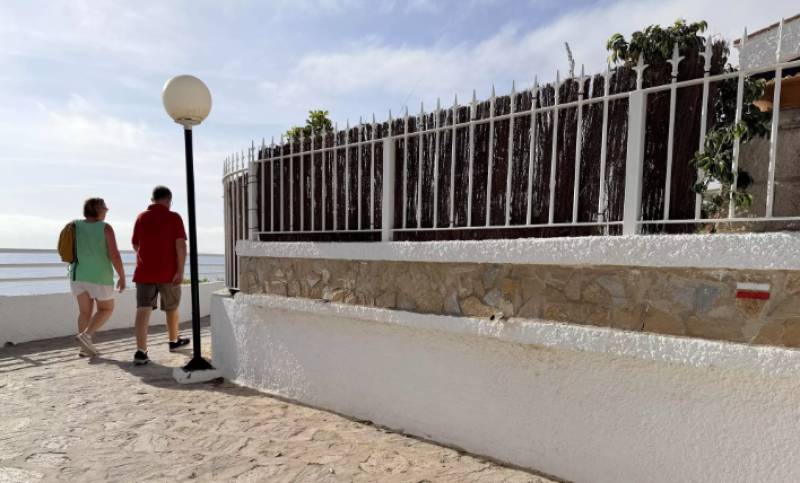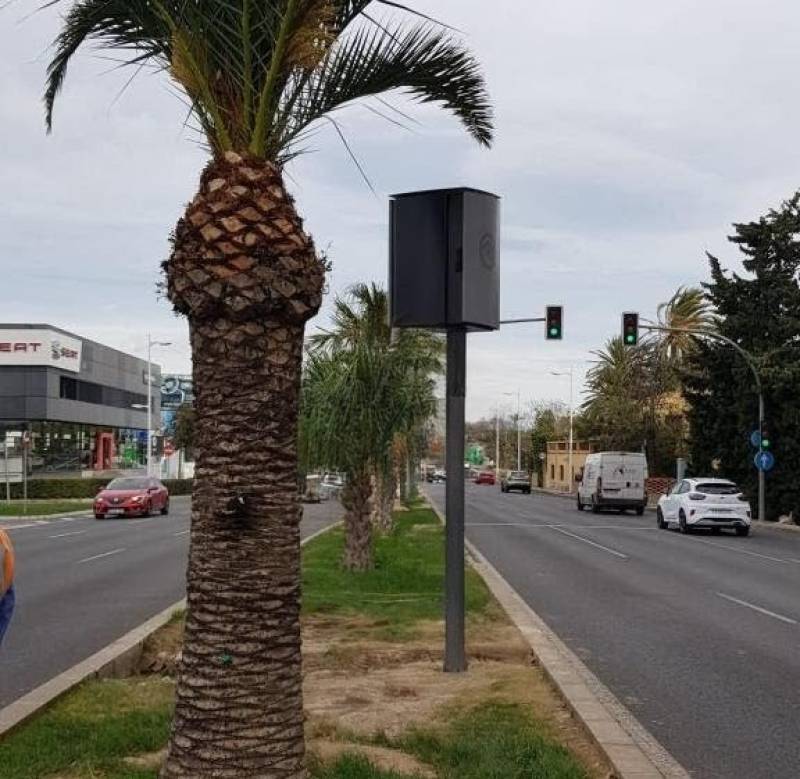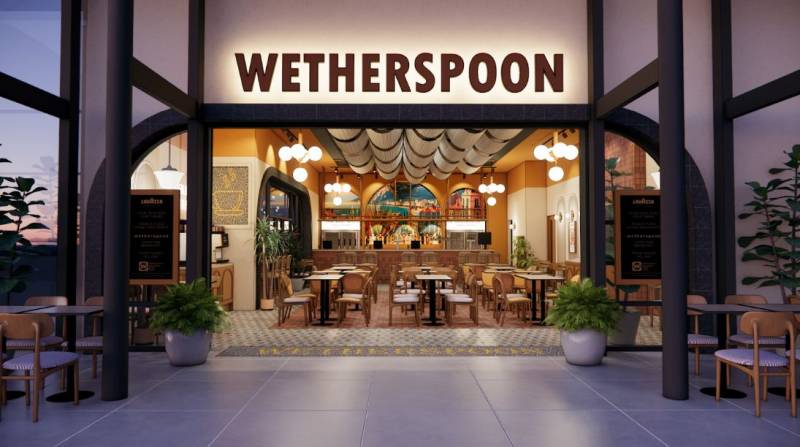

Guidelines for submitting articles to Las Terrazas Golf Resort Today
Hello, and thank you for choosing El Valle Today.com to publicise your organisation’s info or event.
Las Terrazas Golf Resort Today is a website set up by Murcia Today specifically for residents of the urbanisation in Southwest Murcia, providing news and information on what’s happening in the local area, which is the largest English-speaking expat area in the Region of Murcia.
When submitting text to be included on Las Terrazas Golf Resort Today, please abide by the following guidelines so we can upload your article as swiftly as possible:
Send an email to editor@spaintodayonline.com or contact@murciatoday.com
Attach the information in a Word Document or Google Doc
Include all relevant points, including:
Who is the organisation running the event?
Where is it happening?
When?
How much does it cost?
Is it necessary to book beforehand, or can people just show up on the day?
…but try not to exceed 300 words
Also attach a photo to illustrate your article, no more than 100kb

Iglesia de Santiago, Orihuela
A striking Gothic façade conceals a wealth of baroque treasures
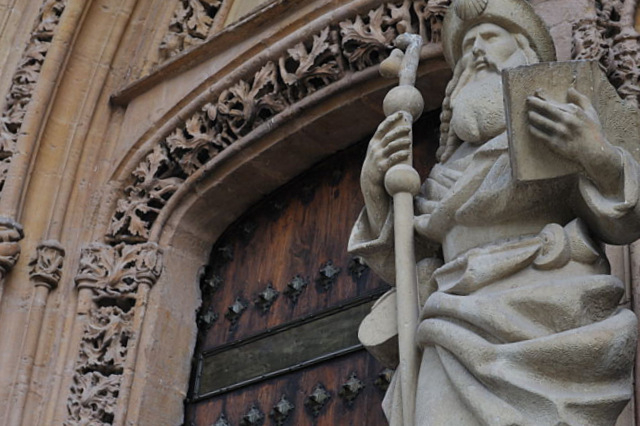 This church on the north-western edge of the old city is located in the Plaza de Santiago, in what is a fairly humble-looking part of Orihuela where the monumental centre begins to merge with the residential areas. However, don’t allow yourself to be misled by the humble nature of the residential property around the church: this glorious little church is a historical and artistic treasure trove!
This church on the north-western edge of the old city is located in the Plaza de Santiago, in what is a fairly humble-looking part of Orihuela where the monumental centre begins to merge with the residential areas. However, don’t allow yourself to be misled by the humble nature of the residential property around the church: this glorious little church is a historical and artistic treasure trove!
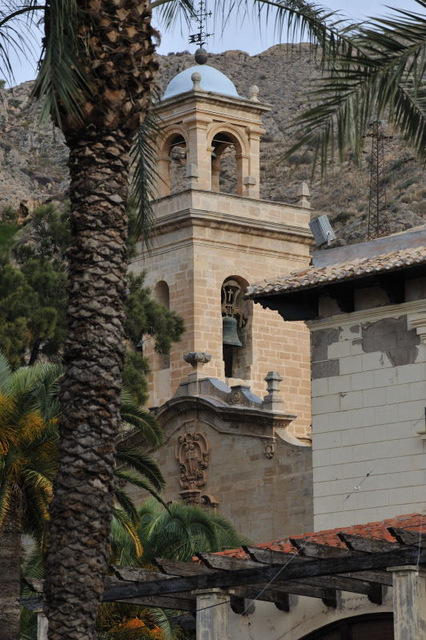 The bell-tower is one of the most emblematic of Orihuela, the small blue dome standing out against the mountain backdrop and in a way capturing the spirit of the city, with its impressive monuments dwarfed by the stark rocky outcrop behind them.
The bell-tower is one of the most emblematic of Orihuela, the small blue dome standing out against the mountain backdrop and in a way capturing the spirit of the city, with its impressive monuments dwarfed by the stark rocky outcrop behind them.
The 14th-century Gothic façade is highly impressive, featuring an ornamental archway showing Santiago (Saint James) himself in the centre and the coat of arms of the Catholic Monarchs ( Isabella and Fernando) above the entrance. Interestingly the insignia of Granada are missing from the shield, due to the fact that the city had not yet been re-conquered when the façade was erected, clearly dating the work to prior 1492. The statue of Santiago was badly damaged in the Civil War and required extensive restoration work after the conflict ended.
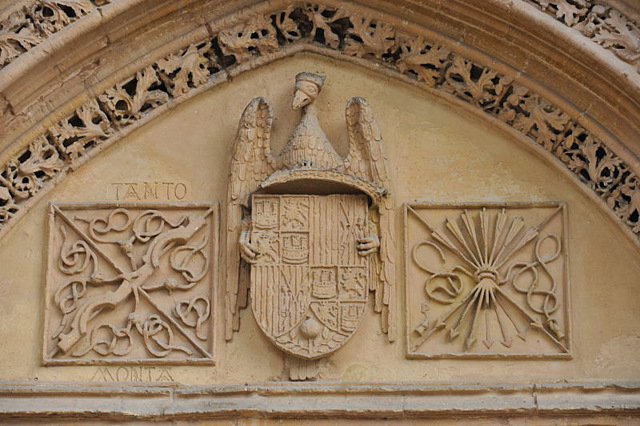 Next to the coat of arms it is possible to make out the words “Tanto monta”. This is an abbreviation of the phrase “Tanto monta, monta tanto”, which equates to “they amount to the same”, an expression of the supposed equality in the marriage between Fernando and Isabella, the Catholic monarchs. Tradition holds that King Fernando held court here in 1488 while attempting to rally troops for his campaign to re-conquer Granada.
Next to the coat of arms it is possible to make out the words “Tanto monta”. This is an abbreviation of the phrase “Tanto monta, monta tanto”, which equates to “they amount to the same”, an expression of the supposed equality in the marriage between Fernando and Isabella, the Catholic monarchs. Tradition holds that King Fernando held court here in 1488 while attempting to rally troops for his campaign to re-conquer Granada.
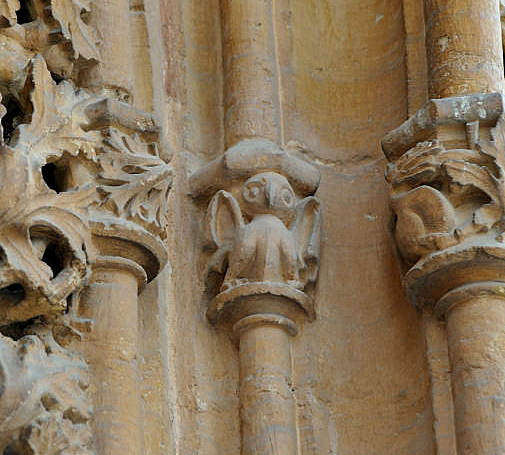 On the right-hand side of the archway just above head height is a small sculpted owl, the significance of which has puzzled observers. Some view it as a symbol of wisdom, while others suspect it may just have been the trademark symbol left by one of the craftsmen working on the arch. However, it has been found that due to its location the owl remains in the shade throughout the year except on the summer solstice of 20th or 21st June, when after 8pm it is touched by the rays of the evening sun. It may be fanciful, but some interpret this as a symbol of the passing from shadow into light, or from unbelief into enlightenment, a theme echoed frequently in religious sculpture and artworks.
On the right-hand side of the archway just above head height is a small sculpted owl, the significance of which has puzzled observers. Some view it as a symbol of wisdom, while others suspect it may just have been the trademark symbol left by one of the craftsmen working on the arch. However, it has been found that due to its location the owl remains in the shade throughout the year except on the summer solstice of 20th or 21st June, when after 8pm it is touched by the rays of the evening sun. It may be fanciful, but some interpret this as a symbol of the passing from shadow into light, or from unbelief into enlightenment, a theme echoed frequently in religious sculpture and artworks.
 There is a second, slightly smaller but equally impressive entrance on the façade, which leads directly into the communion chapel. This chapel was an 18th century addition, and includes a grand baroque altarpiece as well as four paintings by Antonio de Villanueva.
There is a second, slightly smaller but equally impressive entrance on the façade, which leads directly into the communion chapel. This chapel was an 18th century addition, and includes a grand baroque altarpiece as well as four paintings by Antonio de Villanueva.
The main nave was built in the second half of the sixteenth century, and the octagonal sacristy forms a part of it, while the Communion chapel near the main entrance was added in the 18th century. The presbytery is in 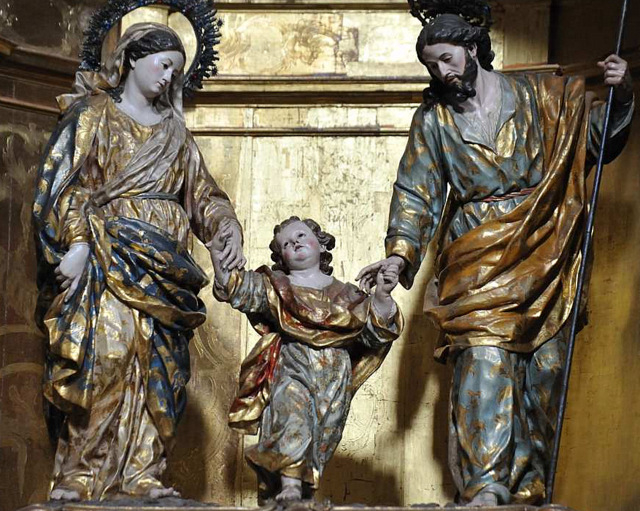 the form of a triumphal arch, and another striking feature is the red marble used in the baptismal font and the altar rail.
the form of a triumphal arch, and another striking feature is the red marble used in the baptismal font and the altar rail.
The baroque pulpit and tabernacle date from the 18th century, as does the organ and the 1765 Salzillo sculpture of the Sagrada Familia. The Santos Dominicos by Salzillo is also housed in the church.
The organ looks out over the nave from above the entrance, and is one of the most striking elements of the building. Orihuela is rightly proud of its church and cathedral organs, and this is perhaps the most impressive 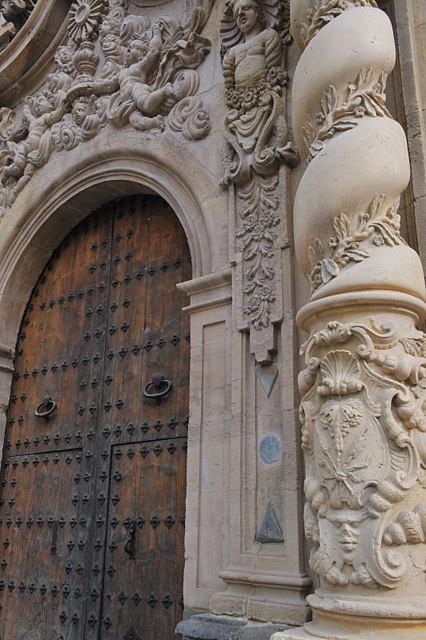 at first glance, if only for size and colour. At the top of the structure is a circular hole, designed so that sunlight would illuminate the Capilla de la Inmaculada. It is mostly gold-plated, and is decorated with a combination of paintings and sculptures, and there are panels bearing images of King David, Saint Cecilia and other musical saints.
at first glance, if only for size and colour. At the top of the structure is a circular hole, designed so that sunlight would illuminate the Capilla de la Inmaculada. It is mostly gold-plated, and is decorated with a combination of paintings and sculptures, and there are panels bearing images of King David, Saint Cecilia and other musical saints.
The design of the organ follows the Austrian model of the time, and is unique in Spain: it has been speculated that the reason for there being Austrian influence in Orihuela derives from the support given to Carlos II, the last Habsburg Spanish monarch.
It’s worth going into the sacristy as well, to admire the marvellous 18th-century baroque furniture and the gothic arch through which the priest used to climb into the old pulpit, as well as the image of Christ on the 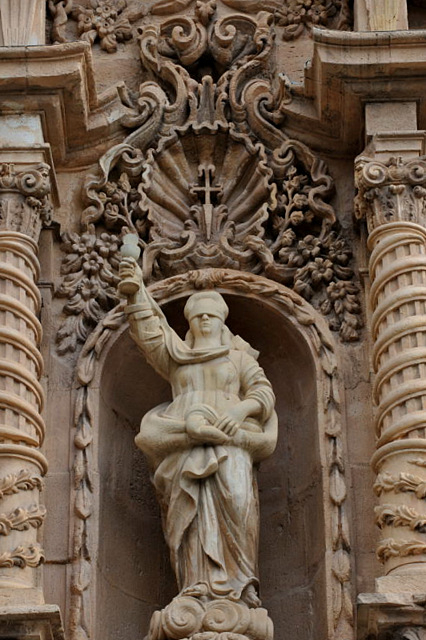 cross by Esteve Bonet.
cross by Esteve Bonet.
The artwork inside the church is an important part of its significance (it was recognized as a National Monument as long ago as 1933).
The Iglesia de Santiago boasts paintings from the schools of Vicente López and Antonio de Villanueva among others, providing a chronicle of different artistic styles and trends from the 17th to the 19th century. Gold and silver work is also prominent here, and the development of the craft is represented from the sixteenth to the nineteenth century, including the “Magno” chalice presented by the Order of Santiago and the “King’s chalice” donated by Felipe III in 1603.
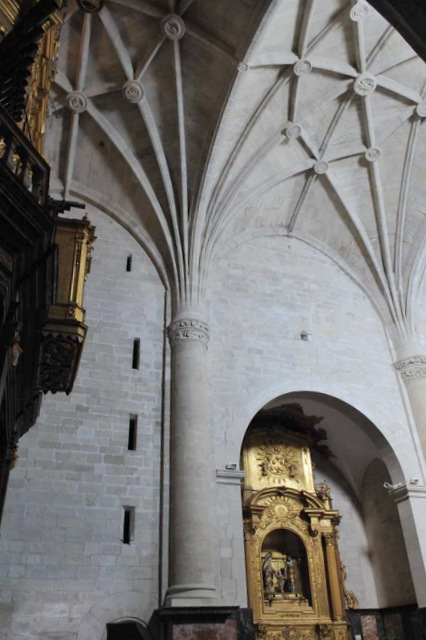 The church possesses an unusually large percentage of important historical works, a rare thing in this part of Spain where hundreds of sculptures and religious artworks were destroyed just before the outbreak of civil war.
The church possesses an unusually large percentage of important historical works, a rare thing in this part of Spain where hundreds of sculptures and religious artworks were destroyed just before the outbreak of civil war.
There are several eighteenth century pieces by Antonio Llopis, including a Sagrada familia ( holy family) opposite which is the “Sagrada Familia” by Francisco Salzillo, one of the Murcia sculptor’s most admired pieces, dating from 1765-66.
Although not one of his largest creations (it measures only 123cm in height) it shows the techniques and characteristic gestures which make his work so distinctive: the use of the estofada technique in which gold leaf is applied beneath the polychrome paint, then the paint carefully rubbed away to create a rippling delicacy on the finished pieces, his mastery of fabric sculpture, creating quilted and bundled effects with the fabric, lending them an indisputable authenticity, his delicate attention to hands, and ability to catch an interaction 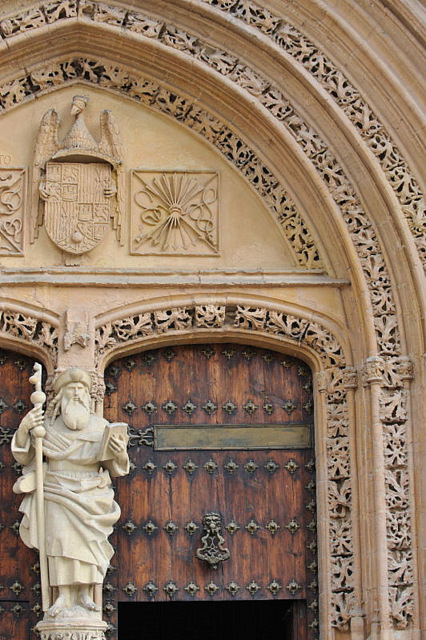 between his subjects, all characteristic trademarks of his work, all of which can be clearly seen in this composition.
between his subjects, all characteristic trademarks of his work, all of which can be clearly seen in this composition.
Visiting hours: Tuesday to Saturday 10.00 to 14.00 and 16.00 to 18.30, Saturdays 10.00 to 14.00
The church is in the Plaza de Santiago, one of the many small squares which adorn the city centre of Orihuela and is a shaded, attractive place to enjoy a sitdown on a hot day. On one side of the plaza is the Palacio de Rubalcava, former home of the Marqueses de Rubalcava, a palace built in the 1930’s in the style of older Orihuelan Baroque palaces. This is a minute’s walk from the Archaeological museum, which also holds an important piece of sculpture by Nicolás de Bussy, la Diablesa.
Iglesia de Santiago, Calle Francisco Die, plaza de Santiago
Click for map, Calle Francisco Die









